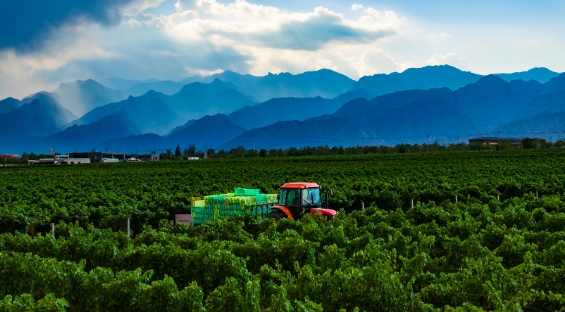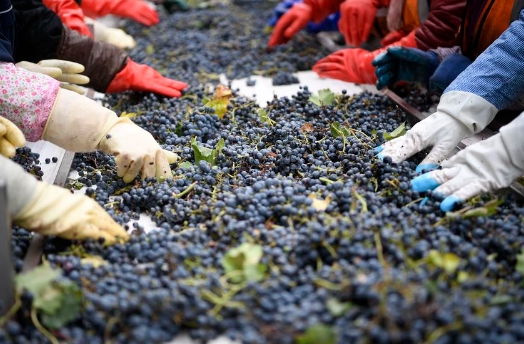Chinese vineyards exploring opportunities in British market

This undated photo shows a vineyard in the eastern foot of Helan Mountain in Yinchuan, northwest China's Ningxia Hui Autonomous Region. (Xinhua)
Wine lovers in the UK are very optimistic about the progress of Chinese wine production and see great potential of Chinese wines in the future.
Near the middle of the vast exhibition hall of the 2025 London Wine Fair, professionals from multiple Chinese vineyards are busy introducing their products to wine experts, buyers and restaurant and hotel owners from Britain and abroad at the stand dedicated for Chinese wines.
The three-day annual wine fair, held from May 19 to 21 in central London, attracted more than 10,000 drinks trade professionals to search for quality products from various countries in the world.
This is the second time that Chinese vineyards attend this wine fair, said Xie Zhentian, co-founder of Vinum Eurus Ltd, a wine selecting and promoting company in Britain. Xie noted that the dedicated exhibition area has been enlarged to nearly five times that of last year.
The company started to introduce Chinese wines to the British market in 2022. When they first brought Chinese wines to Britain, local customers had very little knowledge about these products. So far, a large number of private clubs and hotels offer products featuring Chinese wines.
"Wine lovers in the UK are very optimistic about the progress of Chinese wine production and see great potential of Chinese wines in the future," Xie said some British manufacturers and channels attach great importance to the future development of Chinese wines as the emerging production region is boasted with unique terroir (ecological conditions) and diversified products.

This photo taken on May 21, 2025 shows the 2025 London Wine Fair in central London, United Kingdom. (Xinhua/Zhao Yang)
China's vast territory offers natural diversity of ecological conditions for wine production, for example, the sunshine, temperature and latitude are very different from the eastern and western regions. This ecological uniqueness is an important asset for the attractiveness of Chinese wines, according to Lily Zhang, owner of Fei Tswei Winery.
After trying some Chinese wines produced in northern China, Matt Ovenden, CEO and founder of a British online wine platform named the Wine Engine, said they tasted good and found it interesting when the producer showed them the region on the map and told them the story about the products. He said his company would like to include Chinese wines in their product list.
"Most people in the UK drink wines from France, Africa, Australia, or South America. Imagine if someone had a wine from China, it would become a huge talking point," said David Brookes with the Wine Engine, believing there are a lot of opportunities for Chinese wines in the country.
Highlighting that consumers from Britain are accustomed to trying wines from any new region in the world, Xie viewed the British market as an important hub for Chinese wines to go abroad.
To increase competitiveness in the world market, Chinese vineyards have attached importance to quality. Longting, a vineyard located in eastern China's Shandong Province, adopted the organic approach in nurturing the soil.
When first establishing the vineyard, the planting team dug a trench and applied 120 tonnes of sheep manure and 15 tonnes of volcanic rock powder to make the soil more suitable for growing high-quality grapes. After years of natural grass cultivation, the organic matter in the soil increased three times.
"Our hard work is worth it when we examine the disease resistance quality of our plants," said Sonia Song, founder and owner of Longting Vineyard, noting that the organic farming approach increased the resilience to climate change in challenging years.

Workers sort grapes at a winery at the eastern foot of Helan Mountain, northwest China's Ningxia Hui Autonomous Region, Oct. 14, 2021. (Xinhua/Wang Peng)
With the help of advanced technology, Chinese wine makers are able to achieve more accuracy in production management. For example, employees of Fei Tswei Winery can use mobile phones to control precise irrigation and discover the secret of success of a specific product by tracing data for each production process from the digital management system. In some vineyards, robot cows are also used to help people pick grapes, according to Xie.
To increase the added value of cultural attraction, Chinese vineyards have made innovative designs of wine labels, including iconic elements of traditional Chinese culture, such as ancient legend, famous calligraphy, paintings containing symbolic local plants and animals, as well as cartoon characters and psychological tests that are popular among the younger generation.
"Chinese wines have different grapes and very good quality. It only takes time to be very popular in the UK, and there could be more efforts in marketing," said Joel Placeres, a local restaurant owner.
In order to make overseas consumers more interested in Chinese wine products, it is really important to tell them the story behind the products and organize interactive activities for experience, said Lee Chia-Lin, a business development personnel of the Canaan Winery.
Noting the power of innovation, she gave an example of combining the taste of a specific wine with spicy food from Sichuan, which successfully aroused the strong interest of overseas consumers.
Editor:伏娅敏
